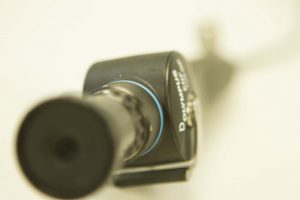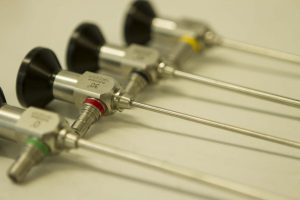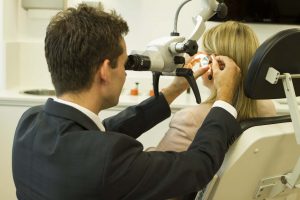Clinic Procedures
A range of procedures can be safely and comfortably performed within Dr Roth’s clinic without the need to book into hospital.
Nasendoscopy
 Nasendoscopy is a commonly performed in office procedure which is necessary to visualise the nasal cavity. It includes assessment of the entrance to the nasal sinuses and their drainage pathway back into the nose. It also allows for detection of abnormalities of the nasal septum, turbinates, Eustachian tubes and adenoid tissue. Nasendoscopy usually requires the nose to be anaesthetised with a spray a few minutes prior to the procedure. There is usually no pain during the procedure.
Nasendoscopy is a commonly performed in office procedure which is necessary to visualise the nasal cavity. It includes assessment of the entrance to the nasal sinuses and their drainage pathway back into the nose. It also allows for detection of abnormalities of the nasal septum, turbinates, Eustachian tubes and adenoid tissue. Nasendoscopy usually requires the nose to be anaesthetised with a spray a few minutes prior to the procedure. There is usually no pain during the procedure.
Laryngeal endoscopy
 Visualisation of the larynx can be performed either via the mouth or nose, depending on patient anatomy. If performed via the nose, anaesthesia with a topical spray is applied a few minutes beforehand. There is usually no pain during the procedure but patients will often feel a sliding sensation in the nose. The entirety of the pharynx and larynx can be visualised. This include the tongue base and vocal cords. In some patients the upper oesophagus can also be assessed.
Visualisation of the larynx can be performed either via the mouth or nose, depending on patient anatomy. If performed via the nose, anaesthesia with a topical spray is applied a few minutes beforehand. There is usually no pain during the procedure but patients will often feel a sliding sensation in the nose. The entirety of the pharynx and larynx can be visualised. This include the tongue base and vocal cords. In some patients the upper oesophagus can also be assessed.
Ear Wax Cleaning
This can be performed comfortably under direct vision using gentle suction without the use of water.
Removal of a foreign body from the ear
 Foreign bodies can find their way into the ears of both children and adults. In children they are often beads, stones or parts of toys. In adults they may be parts of a hearing aid or small insects. Most foreign bodies can be gently and carefully removed with the correct instruments and with the assistance of a microscope. Occasionally they become wedged or painful to remove and require a general anaesthetic to be removed safely.
Foreign bodies can find their way into the ears of both children and adults. In children they are often beads, stones or parts of toys. In adults they may be parts of a hearing aid or small insects. Most foreign bodies can be gently and carefully removed with the correct instruments and with the assistance of a microscope. Occasionally they become wedged or painful to remove and require a general anaesthetic to be removed safely.
Removal of foreign body from the nose
Children occasionally place items in their nose that need to be removed. These items range from piece of food, plastic, beads to more dangerous items like small batteries. Many items can be removed with small micro instruments after the nose is decongested and anaesthetised with a topical spray. Foreign bodies located deeper within the nose may required a general anaesthetic to remove them. Batteries need to be removed urgently (within 24hours) as the acid within them can leak out and cause permanent damage to the nose.
Particle repositioning for dizziness
About 20% of all dizziness is caused by a condition where small particles that assist with balance in the inner ear become dislodged. The symptoms include vertigo, lightheadedness, imbalance and nausea. Symptoms are almost always precipitated by a change of position in the head. A common stimulus is turning in bed or getting out of bed. This condition is called Benign Paroxysmal Positional Vertigo and can be treated in the office with a manoeuvre called the Epley manoeuvre, which Dr Roth can perform.
Insertion of Grommets (Middle Ear Ventilation Tubes)
In some adult patients who have an adequately large ear canal without exostoses (bony growths) or other narrowing, grommets can be inserted under local anaesthesia in the office.
Nasal cautery
 Nose bleeds (epistaxis) are a common referral to an ear, nose and throat specialist. In many instances they can be treated permanently with nasal cautery under local anaesthetic in the office. A numbing spray is applied beforehand so that the procedure is completely painless. It can be used in children and adults.
Nose bleeds (epistaxis) are a common referral to an ear, nose and throat specialist. In many instances they can be treated permanently with nasal cautery under local anaesthetic in the office. A numbing spray is applied beforehand so that the procedure is completely painless. It can be used in children and adults.
Microscopic ear cleaning
The canals can become blocked over time with wax, hair and dry skin. Some people are more prone to this due to narrow ear canals, very dry or excessive wax production or very hairy ears. Initial techniques to clear the ear canals of debris may include the use of over-the-counter wax softening drops or some irrigation by your GP. If these measures fail you may require careful cleaning of the ear canal under the microscope (a micro-ear toilet). This is done by using very gentle suction and microscopic instruments. No water is used and it is usually painless and a great relief to patients. It can be an important part of the management of outer ear infections (otitis externa).
Removal of keratosis obturans
Keratosis Obturans is a disorder of the ear canal where skin cells and wax do not migrate normally from the ear drum and inner ear canal to the outer ear. Over time the ear canals become blocked with skin and wax. This can be so severe that erosion of the ear canal bone can occur as can compression of the ear drum. The treatment is regular microscopic ear cleaning and maintenance with wax softening drops. Occasionally a general anaesthetic is required to safely remove a keratosis obturans at the time of first diagnosis or if the ear has not been cleaned for some time.
Smell studies
Smell problems can be tested through an objective test of 40 different smelling test items.
Removal of skin or mucosal lesions
Dr Roth has a minor procedures room within his consulting rooms. This contains the required equipment to perform biopsy and excision of some skin lesions and lesions within the nose or mouth. It is often more convenient and quicker for patients to have this performed within the rooms rather than within a hospital. This is not always possible due to the size or location of the lesion or other factors such as bleeding risk in patients who are taking blood thinning medications.

